The Jeanie.
6 Dinmont Road, Glasgow. G41 3UD.
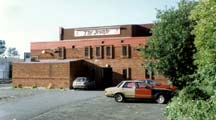
The Jeanie. 1991.
The Jeanie was demolished to make way a new retail and grocer's outlet.
In the NEWS 1977...
A warm welcome from the bonnie Jean Armour...
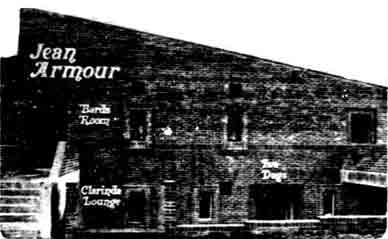
Jean Armour of Dinmont Road, Glasgow's south side, will have a warm welcome for you tomorrow.
And if the name seems familiar, well, the most famous Jean Armour was the wife of Robert Burns.
The new Jean Armour is a complex consisting of public bar, cocktail lounge and function suite, which has cost in excess of 3100,000, and is having the final touches put to it today.
John Waterson, the proprietor of the Jean Armour, has had a special fondness for Burns ever since the success of his first pub, the Burns Cottage.
SNUG
He has named several licensed premises after the poet, including the popular Burns Howff in West Regent Street.
"We have gone for a very high standard of decor and service to cater for the clientele in this part of the city." says Mr Waterson. "Comfort and hospitality are our main aims. A good range of bar snacks will be served, and the menus for the function suite will be reasonably priced."
Each part of the complex has character of its own. Natural timber effects, white rough plastered walls and a cosy "snug" give the distinct Burnstan air to the public bar, the Twa Dogs, which seats 60 to 70.
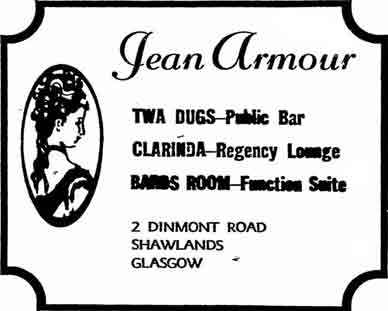
RELAXING
In contrast, the Clarinda Lounge, reflecting the poet's Edinburgh period, has an elegant Regency decor. Seating for only 40 will ensure a pleasantly intimate atmosphere.
The Bard's Room, a self-contained function suite on the upper floor, with accommodation for up to 200, is bright and modern, with its own bar, parquet dance floor and band stand. Concealed coloured lights in the recessed ceiling are a feature of the hall.
A bride's room makes this suite ideal for a wedding reception, and with a well-fitted kitchen, the Bard's Room will also cater for private events and funeral parties.
The complex has fitted carpets throughout and stereo music provides a relaxing background. The building is attractively faced with red French tiles, and is set in three quarter acre of landscaped grounds, with parking space for 70 cars.
John Waterson plans to develop it in the English style, with tables set out in the grounds in good weather.
IDEAS
Paul Waterson, 22 year old son of the proprietor, is the general manager. He has worked in hotel management and gained experience in the Burns Howff. The manager is Lennie Rossi, "Lennie," comments John Waterson, "has some very updated ideas, and will bend over backwards to please the customers."
Before these premises were demolished to make way for a retail and grocers store, this well-known complex was called The Metropolis.
---------------------------------------
In the NEWS 1978...
Drummer Dougie's Pinta Pop Swop...
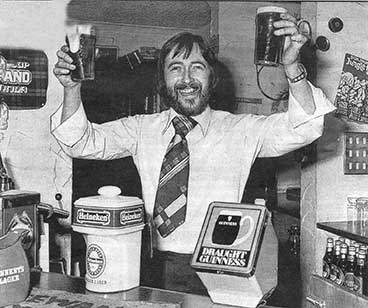
Cheers! Dougie Henderson drums up pints for customers in the pub on Glasgow's South Side at Crossmyloof.
Drinker's in a Glasgow Pub might be excused for thinking they've seen the friendly barman's face before.
For pulling pints instead of fans nowadays id Dougie Henderson, ex-drummer with Scots chart-topping pop group Marmalade.
And that's quite a change for the superstar Glasgow man, who once had Shirley Bassey for drinking company, toured such spots as Brazil and the Far East, and always had a wad of notes in his pocket.
Dougie, who now lives in Pollokshields with his wife, Yvette is charge hand at the Jean Armour pub in Crossmyloof. He spoke today of his life in the pop world, a career which stretched from his fifteenth birthday until 1974.
Great
"I had a great time, from playing with a group of boys at Crookston Castle Secondary School to the Marmalade days." Even as a 15 year-old with a band called the Mad Hatters he was off to Germany for tour dates.
"That was something else," said Dougie. "We played every night for two months. It was just play, eat, bed, then back to playing again."
He played the old Piccaso club with the Hatters when the audience included Dean Ford, Graham Knight and Pat Fairley, then the Gaylords, later Marmalade.
With the Shevlons, then the Cartoon, Dougie made a record and by the time he was 17 appeared on TV's Top of the Pops.
"But I don't even remember the name of the record." he said. "Probably because it flopped." But his first taste of fame arrived while he was playing with the Poets, when they were top of the Scots in the mid-60s. "we were even banned from Fife, would you believe? That was because we were spitting and swearing, they call it punk rock now."
Festival
They moved down to London, came back to Glasgow, then Dougie received a phone call in 1971 from Hughie Nicholson, who had replaced Junior Campbell in the Marmalade line-up. "He asked me to join them and I jumped at the chance."
Dougie recalled: "We toured South Africa, Brazil, at a song festival where we got friendly with Shirley Bassey, and other foreign spots. It was all a bit different from Sauchie town hall and the Hamilton Trocadero.
There was also a string of recording hits including Cousin Norman, Ra Dancer, and Our House is Rocking. The band moved into plush surroundings in Surrey, in a village where Dougie first met his wife, Yvette.
Said Dougie, "It was great up until the middle of 1974 when I quit. We just decided to call it a day, and it was a case of musical differences of opinion."
"I'd never pulled a pint before when publican John Waterson offered me this job. I had known him when the Poets played at the Burns Howff pub years ago."
Said Dougie, "Right now we're converting this place to bring in live groups. I've still got my custom-made American drum kit in the house, and I might just be tempted to sit in with them."

Dougie Henderson (second from right) with members of Marmalade when they were picking up gold discs in London in 1971. From left to right are: Dean Ford; Pat Fairley; Graham Knight; Dougie; and Hugh Nicholson.
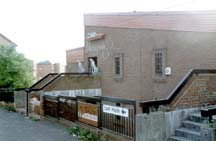
Metropolis 1991.
End.
